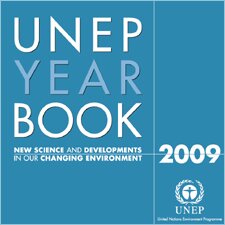UNEP
and Climate Change
The 2014 UNEP Year Book had little on climate change directly, but a chapter on Air pollution is most significant to climate change mitigation.
UNEP's 2013 Year Book had a most climate change important chapter on Rapidly changing Arctic. The Arctic is by far the largest source of large climate change amplifying feedbacks.
The 2010 Year Book had a chapter on Climate change
The extensive Climate change chapter of UNEP's 2009 Year Book explains why action on reducing global warming greenhouse gas emissions is so urgent.

"The Year Book serves as a reminder to the international community as to why a Green Economy is so urgently needed, from the bubbling up of methane gas in the Arctic to the shrinking availability of croplands."
— Achim Steiner, UN Under-Secretary General and UNEP Executive Director, 15 February 2009
Highlights from the UNEP 2009 Year Book and Climate Change Chapter
(References included in these excerpts are listed below.)
- Climate change "is the major, overriding environmental issue of our time, and the single greatest challenge facing decisionmakers at many levels (Ban 2008)."
- Climate change "is a growing crisis with economic, health and safety, food production, security, and other dimensions. Shifting weather patterns threaten food production through increased unreliability of precipitation, rising sea levels contaminate coastal freshwater reserves and increase the risk of catastrophic flooding, and a warming atmosphere aids the pole-ward spread of pests and diseases once limited to the tropics."
- "Mountain glaciers are in alarming retreat and the downstream effects of reduced water supply in the driest months will have repercussions that transcend generations."
- "The potential for runaway greenhouse warming is real and has never been more clear. The most dangerous climate changes may still be avoided if we transform our hydrocarbon-based energy systems to renewable energy systems and if we initiate rational and adequately-financed adaptation programmes to forestall disasters and migrations at unprecedented scales. The tools are available but they must be applied immediately and aggressively."
- "Since 2000, anthropogenic carbon dioxide emissions have been increasing four times faster than in the previous decade. Most of the emissions came from burning fossil fuels and manufacturing cement. These emissions are now 38 per cent above those in 1992, the year governments attending the Earth Summit pledged to prevent dangerous climate change (Global Carbon Project 2008)."
- "The Arctic is warming faster than any other region of the planet. The Arctic also contains very large stores of carbon in the form of methane that may be released as the planet warms. Large-scale methane releases would provide a major positive feedback to global warming and could turn natural ecosystems from carbon sinks to carbon sources, triggering uncontrollable global warming."
- "Growing concern about water shortages highlight new findings on the possible impacts that climate change will have on the hydrologic cycle, including rainfall, soil evaporation, and loss of glacial meltwater flows in rivers. New findings predict empty reservoirs in the Mediterranean and American midwest, dry rivers in China and the Middle East, and less predictable river flows characterized by flash floods in a glacier-free South Asia (Barnett and Pierce 2008)."
- "With possibilities of collapsing ice sheets, methane bubbling out of permafrost, desiccated rainforest ecosystems, and sporadic ocean circulation patterns, concern is growing that Earth's life-support systems are approaching thresholds that contain tipping points."
- "The basic scientific building blocks behind forecasts of widespread and damaging climate change are irrefutable (IPCC 2007). Unless action is taken soon to stabilize and then decrease concentrations of greenhouse gases in the atmosphere, these changes will cause widespread damage to ecosystems, natural resources, human populations, and their fragile economic activities. Such damages could certainly end prosperity in developed countries and threaten basic human livelihoods in developing countries."
References
|
Ban, K. M. (2008). Statement by the United Nations Secretary-General Ban Ki-moon at the opening of the High-Level Segment of COP 14 in Poznan, December 11, 2008
|
Return from UNEP 2009 Year Book and Climate Change to Evidence




